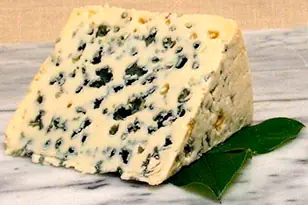Roquefort (French Roquefort) is a French blue cheese. The rights to its preparation belong to only one southern French province of Rouergue. Only the product of this region is considered truly authentic, and everything else is, perhaps of no less quality, but a fake. This region has a rich history of cheese making, as the population has long been involved in sheep farming and sought ways to store and consume milk.
There is a legend about the origin of Roquefort cheese: a young shepherd was so enchanted by a beautiful shepherdess that he forgot about the dinner of bread and cheese stored in a cave...
A couple of days later he returned and found small streaks of mold on the cheese from the rye bread. He did not eat it, considering it spoiled, but later, feeling hungry, the shepherd did not neglect such food. Having tasted a piece of moldy dairy product, he was amazed by the unusual and bright taste of spoiled cheese. This is where the preparation of the famous brand began.
Like all types of cheeses, the production process of this French representative is divided into several stages. Initially, you need to wait until the sheep's milk sours, curd mass and whey form. This process occurs at a temperature of 30 degrees. The cheese mass is placed in fabric bags and, with constant turning, wait until all the whey is completely separated. This takes a couple of weeks. After this, Penicillium roqueforti spores are introduced into the product, which subsequently gives it colored streaks of mold. It is also salted and placed in limestone caves for final ripening. The picky French are sensitive to this process, and therefore pay special attention to all aspects. It should be stored in a well-ventilated area, and the shelves in the grottoes should be made of natural oak and located at different heights. This affects the correct ripening of the cheese.
Roquefort cheese is covered with a white crust, and underneath there is a light buttery mass, permeated with blue stripes of mold. The bright spicy-nutty taste is incomparable to anything. Cheese connoisseurs will also detect notes of sheep's milk. But the production of this food is also carried out using cow food, however, this is no longer that elite Roquefort with an equally elite price. The cow version is much cheaper, but is also in demand due to the high demand for this type of mold cheese.
It must be cut very carefully so as not to damage the mold veins in the structure. A specially designed knife, oriented for cutting this product, looks like a handle with a thin wire stretched on it. However, this knife is also applicable for other similar cheeses with a moldy structure.
Fruits and Burgundy wines go very well with it. Roquefort is also widely used in the preparation of puree soup, pasta, and casseroles.
If precision is observed during the preparation process, the resulting French product is extremely healthy. It contains a large percentage of protein, is well absorbed by the body, and the eight amino acids, vitamins and beneficial bacteria contained in it make it a truly valuable and indispensable food product, both for a bodybuilder and for a mere mortal gourmet.
Post Views: 106


